GETTING THERE
It’s strange how trips are born; the germ of the trip is usually initiated by reading an article, a trip report, or the realisation that a number of your “want to see birds” can best been seen at a specific location. It is at this point that the germ either grows or withers on the vine. We can distinctly remember lying in bed one Sunday morning reading an article on the Asa Wright Centre in Trinidad, we knew instinctively that this was a “must visit place” and the more we read, the greater the realisation became that this was to be our next trip. This is what happens with most of our trips these days, the sudden realisation that this has to be our next trip. The viewing of Malcolm Rymer’s CDs, Birding in Bulgaria, was the catalyst for this trip.
With the tightening of airport security, airlines have been able to treat the travelling public with disdain; this, in the main, has made air travel much less appealing for us these days. This has manifested itself in our reticence to travel any further than our local airport (Birmingham). With direct long haul destinations from B’ham being limited to just a few countries it has meant our birding trips are now restricted in the main to Europe. Having birded most of southern and central Europe, serious birding in this part of the world doesn’t have the same appeal it once had.
With Malcolm’s CD rekindling all the old enthusiasm, Bulgaria was chosen as our next trip abroad. It was our intention to travel independently as we usually do, but to engage a guide or guides for the duration of our 2 week trip. It soon became apparent that our ‘most wanted’ list had birds scattered across the whole of Bulgaria, so a Bulgarian speaking guide was a must if we didn’t want to waste time finding the birding locations for ourselves. To this end we contacted Neophron Tours a company who specialise in birding and wildlife trips around Bulgaria.
Neophron are allied to the Bulgarian Society for the Protection of Birds and have several guides on their books: all have degrees in botanical, environmental, or associated subjects, are experienced in leading parties large and small and know their country intimately. Our contact for Neophron was Dimiter Georgiev. Contact was carried out by email. Dimiter was very proficient, returning our emails promptly, supplying us with all the information we requested.
This instilled enough confidence in Neophron for us to supply them with the species we wished to see and then to leave all the arrangements excluding air travel to them. They came up with an itinerary that suited our needs and soon we were sealing the deal with a deposit of €700. We kept in contact with Neophron during the winter and just after Christmas Dimiter contacted us to inform us that our guide for the trip was to be Mladen Vasilev.
Mladen is a graduate of the Shuman University, where he left with a major in “Ecology & Environmental Protection”. He is a very accomplished wildlife photographer and has published many photos in both Bulgarian and European Magazines. He has been leading tours for Neophron since 2005.
We discussed the optimum time for the trip with Neophron and agreed that early May was best, so the trip was scheduled for 14 days starting on 8th of May. The total cost for the trip for the pair of us, excluding the flights, was €2,760. This included all accommodation, transport and the services of a guide. The flights were £294 for the two of us. Car parking and holiday insurance had to be added.
Our birding itinerary dictated that we start south of the capital so our airport had to be Sofia. Birmingham Airport offer no flights to Sofia so we chose British Airways who offered flight times that suited. Unfortunately this meant travelling down to Heathrow, flying out of the new Terminal 5. Heathrow would probably be our second choice airport as we live just 6 miles from Junction 15 on the M40. With a fair wind and kind traffic conditions Heathrow is little more than an hour and a quarter down the motorway.
DAY 1 – Western Radopes
We left home at 05.00hrs and had an eventless drive down to Heathrow in a persistent heavy drizzle. On arrival at the long stay car park we were invited to use the new pod rapid transit system. ”It was great”. Soon we were being swiftly processed through the departure lounge.
It was at the security check-in that things changed. Here we were greeted by some of the foulest tempered female staff we have ever encountered at any airport the world over. 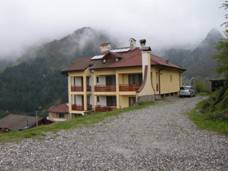 Snarling instructions on what items to put in what trays, they insisted that the trays had to be put on the conveyer by the owner of the contents and then chastised everybody because the trays weren’t dropping through to the return conveyer.
Snarling instructions on what items to put in what trays, they insisted that the trays had to be put on the conveyer by the owner of the contents and then chastised everybody because the trays weren’t dropping through to the return conveyer.
Although the flight was slightly delayed we made up the lost time and met Mladen, our guide for the trip, at the airport at the prescribed time. Although the British Airways web site had told us to expect sunny conditions with temperatures touching 21°C we actually arrived in very dull conditions with a high of 10°C. By the time we had left Sofia we were encountering the same weather conditions we had left in England and when we had covered just a few miles, the rain started and continued right to our first overnight stay in the Hotel Kris. A small family run hotel, above the mountain town of Devin and a journey of about 4 hours, putting paid to any en route birding. Just a few common species were observed from the vehicle, the most notable being 2 sightings of White Stork.
DAY 2 – Western Radopes
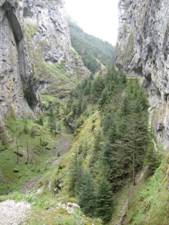 The day dawned very much as the last one had ended; bloody miserable, cold & wet. Undaunted, we ventured out at first light, eager to get some meaningful birding in. Birds of note seen during this pre-breakfast amble were Serin, Black Redstart, White Wagtail and Spotted Flycatcher. We returned to the hotel slightly moistened for a breakfast of scrambled eggs on toast.
The day dawned very much as the last one had ended; bloody miserable, cold & wet. Undaunted, we ventured out at first light, eager to get some meaningful birding in. Birds of note seen during this pre-breakfast amble were Serin, Black Redstart, White Wagtail and Spotted Flycatcher. We returned to the hotel slightly moistened for a breakfast of scrambled eggs on toast.
The next stop was Trigrad Gorge, for never to be forgotten views of Wallcreeper nest building and a fly past of Peregrine Falcon clutching an Alpine Swift in its talons. A couple of young Ravens flew back & forth through the gorge complaining bitterly at being evicted from the nest. Dippers, and wagtails were also encountered. A light lunch was taken before we embarked on the long drive to the Western Radopes.
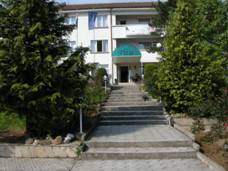 We made several short birding stops en route, one of which was at a small picnic area which still had a covering of snow. We were greatly surprised by the density of Ring Ouzels encountered in such a small area; at least a dozen birds. Great views of Crested Tit, Firecrest and Black Redstart were also enjoyed. A possible Nutcracker was also called, but the views were too fleeting to confirm the species.
We made several short birding stops en route, one of which was at a small picnic area which still had a covering of snow. We were greatly surprised by the density of Ring Ouzels encountered in such a small area; at least a dozen birds. Great views of Crested Tit, Firecrest and Black Redstart were also enjoyed. A possible Nutcracker was also called, but the views were too fleeting to confirm the species.
As we entered the Western Radopes the terrain changed dramatically, as did the birds with shrikes, bee-eaters, storks, eagles and vultures now the order of the day. We arrived at the Hotel Ray in the old mining town of Madzarovo a little after 19.00hrs tired and happy. Bring on tomorrow!
DAY 3 – Western Radopes
05.45hrs saw me standing outside the hotel waiting for Mladen to transport me to the photographic hide at the vulture feeding station, an opportunity I couldn’t pass up. Ensconced in a very small, cramped hide for 2hrs produced some fine shots of a pair of Egyptian Vultures picking over the scraps of a carcass deposited several days earlier. Mladen had explained that as there was little of the beast left to feed on, the chances of larger vultures arriving, were very slim.
After breakfast we made the short journey to a large massif with towering cliffs, parking in a small scrubby area where Nightingale appeared to sing from almost every bush. We slowly made our way along the base of the massif for a couple of kilometres. Many species were heard singing, such as Barred Warbler, Eastern Orphean Warbler, Golden Oriole and Bee-eater but it was a challenge to actually see them in the dense vegetation. 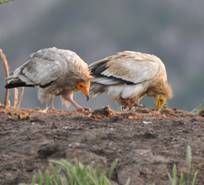 However, good views of Subalpine Warbler, Middle-spotted Woodpecker, Woodchat Shrike, both Black & White Stork, Turtle Dove, Short-toed Eagle, Long-legged Buzzard, Egyptian and Griffin Vultures were had.
However, good views of Subalpine Warbler, Middle-spotted Woodpecker, Woodchat Shrike, both Black & White Stork, Turtle Dove, Short-toed Eagle, Long-legged Buzzard, Egyptian and Griffin Vultures were had.
Further along the Massif other birds of note were encountered, including Peregrine, Kestrel, Alpine Swift, Crag Martin, Blue Rock Thrush and Red-rumped Swallow. Several Rock Buntings were heard but even with extensive scanning of the rock-face their presence remained undetected. Lunch was taken at the Vulture Centre prior to a drive at a higher elevation through more open savannah. With the exception of a very close low flying Black Vulture and actually seeing the earlier elusive Barred Warbler, little of note was seen.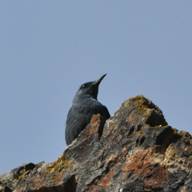 Our final destination for the day was a large lake at Borislavci, where we encountered our first wetland birds of the trip. Black & Whiskered Tern as well as Little Egret and Grey Heron were added to the list. A small run-off from a farm water tank gave bathing opportunities to Yellow Wagtail, Goldfinch and Spanish Sparrow, as well as providing nest building material to both House Martin and Barn Swallow. Again, far too much time was spent trying to photograph, firstly a Barred Warbler and then an Olivaceous Warbler. Both these birds had got the “now you see me, now you don’t” tactic off to a fine art.
Our final destination for the day was a large lake at Borislavci, where we encountered our first wetland birds of the trip. Black & Whiskered Tern as well as Little Egret and Grey Heron were added to the list. A small run-off from a farm water tank gave bathing opportunities to Yellow Wagtail, Goldfinch and Spanish Sparrow, as well as providing nest building material to both House Martin and Barn Swallow. Again, far too much time was spent trying to photograph, firstly a Barred Warbler and then an Olivaceous Warbler. Both these birds had got the “now you see me, now you don’t” tactic off to a fine art.
DAY 4 – Eastern Radopes
A more leisurely breakfast was taken at 07.30hrs and a little after 08.00hrs we were on the road to the dam at Studen Kladenec and the Vulture feeding station beyond. Target birds were similar to the previous 2 days, with an emphasis on shrikes & raptors. Our first stop was looking over a wooded valley with high mountains on both sides. Our first new bird for the trip was a distant solitary Chukar; good scoped views were had, which can’t be said for the next bird, “called” Golden Eagle – although the bird was definitely an eagle the silhouetted image was not sufficient for us to award it a tick. Woodlark, Jay and Black-eared Wheatear also went in the book.
Our drive to our next destination produced several Woodchat and Red-backed Shrike and a splendid Lesser Grey was also noted. A roadside puddle was being used by Barn Swallow, Red-rumped Swallow and House Martin for nesting materials and both House & Spanish Sparrow were using the same puddle for their morning ablutions. Our next stop was a lay-by above the dam where we had great views of Egyptian Vulture and Black Stork on their nests. We were treated to wonderful views of synchronised display flying by the storks and a slow soaring fly-by of a Goshawk from the wooded valley below.
Leaving the dam we made our way to the area around the vulture feeding station, just outside the Turkish village of Potocarka. 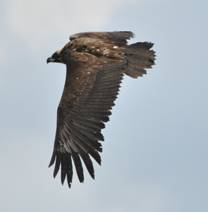 Here we had a picnic lunch in the company of Northern and Isabelline Wheatear, Woodchat Shrike, Eastern Orphean Warbler, Roller and Cirl Bunting. Griffon Vulture were dropping down into the adjacent valley, to what we assumed was a carcass – all this to a crescendo of Nightingale song… “fantastic”.
Here we had a picnic lunch in the company of Northern and Isabelline Wheatear, Woodchat Shrike, Eastern Orphean Warbler, Roller and Cirl Bunting. Griffon Vulture were dropping down into the adjacent valley, to what we assumed was a carcass – all this to a crescendo of Nightingale song… “fantastic”.
We retraced our steps back to the hotel, picking up both Booted & Short-toed Eagle and a pair of Bee-eater who were excavating a nesting hole on the side of the road. After our evening meal we were alerted by Mladen to three singing Scops Owl not far from the hotel. Mimicking their calls, it wasn’t long before we had one, no more than 3 metres above our heads in a pine tree just outside the hotel door. A torch was used to give excellent illuminated views. A very satisfying and tiring end to another super day’s birding.
DAY 5 – Moving day
Today we left the Western Radopes for the coast, a distance of over 100 kilometres, but not before we checked out several new sites and new birds. Our first stop was at a site visited the previous day, in an attempt to get better views of the Rock Bunting which were proving particularly hard to obtain. With the buntings still being un-cooperative, good positive identification took much longer than expected, with a distant Ortolan Bunting raising hopes as it masqueraded as it’s close cousin on several occasions. Staying much longer than intended, and with more great views of the vultures, Crag Martin, and Blue Rock Thrush etc, we departed by late morning.
Our next stop was overlooking a wooded valley where Levant Sparrowhawk breed. However this particular species proved elusive, with only very distant un-tickable views of the female obtained. Compensation, however, was had with great views of Masked Shrike, Hawfinch, Penduline Tit and a pair of tumbling Roller.
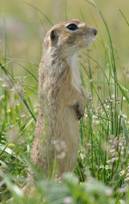 A light lunch was taken before our next stop, which was at a known Eastern Imperial Eagle nest site. Good, but distant scoped views of the female on the nest were had; however much better views of the male, actively hunting the many Souslik that abounded there, was fair compensation. A Lesser Spotted Eagle and Marsh Harrier floated by, while a male Red-footed Falcon went through at a less sedate pace. Honey Buzzard was also noted nearby.
A light lunch was taken before our next stop, which was at a known Eastern Imperial Eagle nest site. Good, but distant scoped views of the female on the nest were had; however much better views of the male, actively hunting the many Souslik that abounded there, was fair compensation. A Lesser Spotted Eagle and Marsh Harrier floated by, while a male Red-footed Falcon went through at a less sedate pace. Honey Buzzard was also noted nearby.
We arrived at the Hotel Mirana in Bourgas in the early evening leaving just enough time to shower prior to another “memorable” evening meal.
DAY 6 – Bourgas Wetlands
Today was our first chance to get to grips with some of Bulgaria’s many wetland species, both resident and passage. 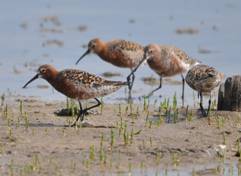 Breakfasted, we were on the road by half past eight, stopping firstly at Atanasovsko salt works. Three mini-buses containing Dutch birders were well ensconced on our arrival. Many small waders were evident and it wasn’t long before Curlew Sandpiper, Dunlin, Little & Temminck’s Stint, Black-winged Stilt, Avocet and Ruff, together with an assortment of terns & gulls were being logged and in some cases photographed.
Breakfasted, we were on the road by half past eight, stopping firstly at Atanasovsko salt works. Three mini-buses containing Dutch birders were well ensconced on our arrival. Many small waders were evident and it wasn’t long before Curlew Sandpiper, Dunlin, Little & Temminck’s Stint, Black-winged Stilt, Avocet and Ruff, together with an assortment of terns & gulls were being logged and in some cases photographed.
Staying longer than intended, it was late morning before we arrived at our second destination Bourgas Lake, a large lake that initially appeared to hold little birdlife. Once the scopes were employed, both White & Dalmatian Pelican, Squacco & Night Heron, Little Bittern, Spoonbill and again a selection of both gulls & terns, together with very obliging Reed & Great Reed Warbler, were all seen well.
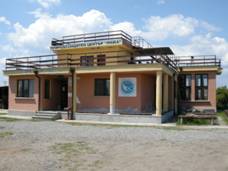 It was now early afternoon and lunch beckoned; it had already been agreed to have a packed lunch at the Bulgarian Society for the Protection of Birds reserve at Poda. This was taken on the observation balcony of the centre, so we could eat and continue birding. Although this is a very nice site, it was not the most productive we had visited. Several tern platforms held both breeding Common & Little Tern, together with the occasional Pygmy Cormorant. The one thing that we found fascinating was that there were hundreds of Cormorants nesting all over the superstructure of derelict electricity pylons.
It was now early afternoon and lunch beckoned; it had already been agreed to have a packed lunch at the Bulgarian Society for the Protection of Birds reserve at Poda. This was taken on the observation balcony of the centre, so we could eat and continue birding. Although this is a very nice site, it was not the most productive we had visited. Several tern platforms held both breeding Common & Little Tern, together with the occasional Pygmy Cormorant. The one thing that we found fascinating was that there were hundreds of Cormorants nesting all over the superstructure of derelict electricity pylons.
An hour passed and we were soon on our way to our next site, when a chance sighting of half a dozen aerial Glossy Ibis prompted a roadside stop, adjacent to a marshy area. Spoonbill, Squacco, Purple & Grey Heron, Little, and Great Egret, Marsh Harrier and Red-footed Falcon were all noted, together with a very vocal Cuckoo. 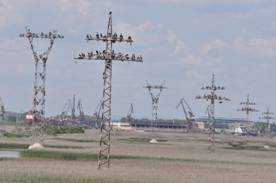 Continuing on, many birds were observed from the travelling vehicle, a notable one of these was a male Montagu’s Harrier quartering nearby fields.
Continuing on, many birds were observed from the travelling vehicle, a notable one of these was a male Montagu’s Harrier quartering nearby fields.
The west end of the Bourgas Lake was visited next. Here the emphasis was on the several tern species that use the lake. We had great views of Black, White-winged, Whiskered, Little and Common Tern, all seen at close quarters. A Little Gull circled and obligingly settled on the lake to give great views of this species’ transformation from summer to winter plumage.
Our final stop was at the south end of the previously visited Atanasovsko salt works. Many of the same species were observed, with the notable additions of a splendid Terek Sandpiper and Ruddy Turnstone, both new for the trip. The Turnstone proved particularly hard as the bird spent all its time in a channel between timber piles, giving only tantalising head shots. It was only after many minutes, when the bird briefly climbed onto the piles, that we were able to positively identify it. Both Spotted Redshank and Shoveler were also present.
The calls of a nearby Penduline Tit prompted us into photography mode. A frustrating half hour soon passed with less than acceptable photographic shots of this lovely little bird, although good views through the bins were had. Another frustrating, but great end to another super birding day.
DAY 7 – Pomorie Salt Pans and Hills
Today we were going to concentrate on the vast salt workings at Pomorie. Starting at the north, we would bird various vantage points until we reached the southern end. Many of the same birds were encountered as yesterday. Hundreds of Curlew Sandpiper, with lesser numbers of Ruff, Little Stint, Ringed Plover, Dunlin and Kentish Plover were noted. However, some notable additions were added: Black-tailed Godwit, Grey Plover, Greenshank, Little Ringed Plover, Sanderling and Lapwing. A dozen or so Little Gull hawked the pans in various plumages. A flypast of three Collared Pratincole and a single Gull-billed Tern were also added to our growing tick list.
A late picnic lunch was taken at the Pomorie Visitor Centre overlooking the vast Sandwich Tern colony. Little Tern and Common Tern vied for air space, whilst many Cormorant stood sentinel on the numerous old timber pilings. Close scrutiny of the Tern Colony turned up several Mediterranean Gull, with a couple of dozen Avocet.
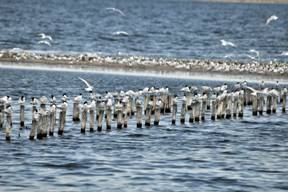 Having spent the best part of 4 hours trawling through thousands of waders in very warm conditions, we decided to take to the hills. Our selected spot was a track leading off the road to Kozicino. An open area with scattered trees, bordered by a small stream seemed ideal and so it proved to be. Notable birds encountered were Bee-eater, excavating their nests in the steep bank above the stream and many Hawfinch, using the river to drink and bathe. A Grey-headed Woodpecker was heard calling; some serious field-craft by Mladen located the bird at its nest site. Golden Oriole, Three-toed Treecreeper, Cirl Bunting and Red-backed Shrike all helped to make for a very impressive supporting cast.
Having spent the best part of 4 hours trawling through thousands of waders in very warm conditions, we decided to take to the hills. Our selected spot was a track leading off the road to Kozicino. An open area with scattered trees, bordered by a small stream seemed ideal and so it proved to be. Notable birds encountered were Bee-eater, excavating their nests in the steep bank above the stream and many Hawfinch, using the river to drink and bathe. A Grey-headed Woodpecker was heard calling; some serious field-craft by Mladen located the bird at its nest site. Golden Oriole, Three-toed Treecreeper, Cirl Bunting and Red-backed Shrike all helped to make for a very impressive supporting cast.
A less productive visit to a large marshy area brought birding for the day to a close.
DAY 8 – Moving North
Today we moved north to Kavarna to explore the wetlands there, but before moving on we made a last visit to the Pomorie salt works. No new birds were detected, although good views of Avocet, Curlew Sandpiper, Little Stint, Temminck’s Stint and Ruff were again had. Many dozens of Shelduck fed in the pans beyond. Several stops were made during the day, usually for a targeted species. Our first stop was at a small sheep drinking trough in the woods, a known haunt for Hawfinch; a species we had encountered many times during the trip but one that had eluded us photographically. Another blank, but the stop did produce several trip ticks including Green Woodpecker, Mistle Thrush, Spotted Flycatcher and Robin.
Our second stop was for lunch at a restaurant in vast beech woodlands. A great place for Semi-collared Flycatcher which nest in boxes located around the grounds. Another bird on our photographic hit list; we resisted the temptation to snap the obliging females in favour of the more diagnostic male. Our male was not for being photographed, using every trick in the book to elude the camera. We were subsequently informed that that was probably our best opportunity to snap the species. Pity we hadn’t been informed earlier, at least we could have had a female in the can. Anyway the chicken soup was good!
Our third stop was at a sprawling holiday complex which incorporated a large area of riverine forest giving good access. What a great stop this was. Middle-spotted, Grey-headed, Greater-spotted and Black Woodpecker were all seen very well. However, the photographic curse continued. Although we had great views of Black Woodpecker, the bird had chosen to feed in a heavily shaded area, rendering photography impossible. A male Semi-collared Flycatcher was also located; he must have been closely related to the previous one as he wasn’t for photographing either.
Our final stop was at a known Eagle Owl nest site, where we had distant heat haze affected views of the Owl. We arrived at Kavarna late in the afternoon. Not our best day photographically or species wise.
DAY 9 – Durankulak Lake
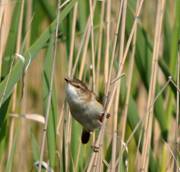 Today we spent the whole day around Durankulak Lake; this is a large coastal freshwater lake with extensive shallow, reed-fringed marshes at both ends. Our main quarry was the Paddyfield Warbler. The lake is believed to contain one of the only breeding populations of this warbler in Europe. Birding en route we reached the lake mid-morning.
Today we spent the whole day around Durankulak Lake; this is a large coastal freshwater lake with extensive shallow, reed-fringed marshes at both ends. Our main quarry was the Paddyfield Warbler. The lake is believed to contain one of the only breeding populations of this warbler in Europe. Birding en route we reached the lake mid-morning.
A strong on-shore wind was blowing on our arrival at the northern end of the lake. Our guide Mladen was concerned that this could badly affect our chances of seeing the bird. Undaunted we made our way down to the lake and were almost immediately greeted by a very obliging Great Reed Warbler, who gave great views through the bins and the same through the camera lens. Mladen thought our best bet for the Paddyfield was to look in the reeds in the lee of the sand dunes where the wind would be less severe.
This was inspired, because as soon as we arrived we were confronted with two skirmishing males. It was soon apparent that we were on the border of two adjoining territories; with good views of both birds, we decided to concentrate our efforts on the right hand male as he seemed the bolder, climbing to the tops of the swaying reeds to proclaim his territory. With patience and time, more than acceptable photos were obtained. 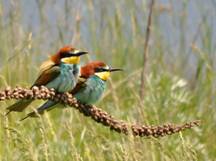 Purple Heron, Little Bittern, Ferruginous Duck and Whiskered Tern were also noteworthy sightings. Leaving the north end we made our way to the south of the lake; this was accessed via a very long deep rutted coastal dirt track with large clay cliffs separating us from the sea.
Purple Heron, Little Bittern, Ferruginous Duck and Whiskered Tern were also noteworthy sightings. Leaving the north end we made our way to the south of the lake; this was accessed via a very long deep rutted coastal dirt track with large clay cliffs separating us from the sea.
A large colony of Bee-eater was nesting here so a stop was made to watch. Although flight shots in the strong wind were nigh-on impossible, the birds would occasionally oblige by perching on dead Asphodel heads where some good report shots were had.
After a stop for lunch at a village tavern we made our way to a large municipal building set in landscaped gardens with large mature trees. “Who’s for Long-eared Owl then?” Mladen asked. Almost as soon as we had got through the gates we were confronted by a striking male Syrian Woodpecker, adjacent to a couple of obvious nesting holes. We binned the bird for a minute or two but before we had time to raise our cameras the bird was gone. We staked out what we thought was the nesting site, whilst Mladen went in search of the promised Owl. 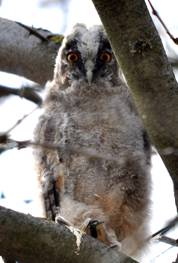 It wasn’t long before we were being beckoned to view a fluffy owlet, sat in a tree yet to come into leaf. A second owlet, then an adult and then a third owlet were found in adjacent trees. A great start to the afternoon’s birding. Not long after, the female Syrian Woodpecker returned and started excavating material from a nesting hole. Whirring camera shutters were very evident once again.
It wasn’t long before we were being beckoned to view a fluffy owlet, sat in a tree yet to come into leaf. A second owlet, then an adult and then a third owlet were found in adjacent trees. A great start to the afternoon’s birding. Not long after, the female Syrian Woodpecker returned and started excavating material from a nesting hole. Whirring camera shutters were very evident once again.
Difficult as it was, we eventually pulled ourselves away to make the last site visit of the day. Shabla Lake was very similar to Durankulak; a large body of open water shallowing out to large reed-fringed swamps. Birds of note seen here were: Glossy Ibis, Great Egret, Little Egret, Ferruginous Duck, Levant Sparrowhawk and Pied Wheatear. Many shrikes, orioles, buntings etc were also observed during our travels.
DAY 10 – Cape Kaliakra and the coastal Steppe
Today was a day very much dedicated to those LBJs – lark & pipit species not seen in any great numbers on the trip. We concentrated our efforts on Cape Kaliakra, a peninsula that extends into the Black Sea for several kilometres and some adjacent Steppe.
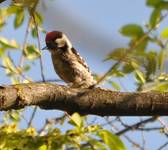 Our first date, however, that morning was with a Lesser-spotted Woodpecker Mladen had heard constantly calling in the park adjacent to our hotel. Again, the bird was heard calling and very soon located, high up in the mature Ash trees. Both birds were seen and appeared to be in a kiss-and-chase-mood, with the female constantly moving and the male following and then displaying. Eventually a few less than ideal record shots were obtained and we were able to return to the hotel for breakfast.
Our first date, however, that morning was with a Lesser-spotted Woodpecker Mladen had heard constantly calling in the park adjacent to our hotel. Again, the bird was heard calling and very soon located, high up in the mature Ash trees. Both birds were seen and appeared to be in a kiss-and-chase-mood, with the female constantly moving and the male following and then displaying. Eventually a few less than ideal record shots were obtained and we were able to return to the hotel for breakfast.
Breakfasted by eight, we were on the road soon after, arriving at the Cape a little before nine. The Cape is very popular with day trippers and Mladen wanted to be there well before the madding crowd. Our main target bird was the Pied Wheatear, which happened to be almost the first bird we saw; a splendid male followed closely by a female with a beak full of nesting material. Alpine Swift was also a target, although a slightly lesser one, as we had encountered these on a couple of occasions previously. It wasn’t too long before we saw several birds from the breeding colony wheeling above the ruins.
A flock of 30+ Yelkouan Shearwater was spotted not far from shore, together with three late-departing Black-throated Diver. Seven Eurasian Shag were also new to the list, as was a very obliging Red-breasted Flycatcher. Common Swift, Barn Swallow, House Martin, Linnet and Black-headed Bunting made up the supporting cast.
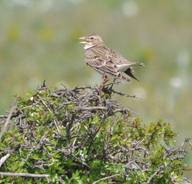 After several hours on the Cape it became obvious that the influx of day-trippers had started, so we left for a quieter environment. Our next stop was a steep narrow gorge with a large reeded wetland at its base. Although this area proved a little disappointing in species seen, we did manage good views of several Purple Heron and a Squacco. The area was exceptional in the numbers of Thrush Nightingale it held. Almost every 100 metres travelled produced another singing male. Several were encountered feeding on the side of the road. All the usual species were seen and several Cuckoo constantly called overhead.
After several hours on the Cape it became obvious that the influx of day-trippers had started, so we left for a quieter environment. Our next stop was a steep narrow gorge with a large reeded wetland at its base. Although this area proved a little disappointing in species seen, we did manage good views of several Purple Heron and a Squacco. The area was exceptional in the numbers of Thrush Nightingale it held. Almost every 100 metres travelled produced another singing male. Several were encountered feeding on the side of the road. All the usual species were seen and several Cuckoo constantly called overhead.
Our last site for the day was an extensive area of sheep-grazed steppe, with bare areas of limestone and many boulders favoured as singing posts for our target species. Anything little and brown, that runs along the ground. Calandra Lark, Short-toed Lark, Tawny Pipit, Red-throated Pipit and Stone Curlew, all steppe specialities, were seen in their dozens, plus several unexpected Thrush Nightingale. Red-footed Falcon, Roller, Spotted Flycatcher and several species of shrike were also observed.
Another great day in the field, with all target species seen well, together with a few bonus sightings.
DAY 11 – The Big Push
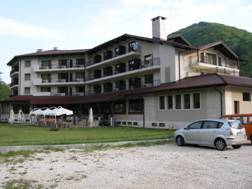 Leaving the coast today our next stop was the central Balkan Mountains some 400+ kilometres inland. Some two and a half hours into our journey we stopped at a roadside restaurant with a large lake to the rear; a quick scan of the lake, whilst waiting for our coffee to be served, produced two new trip ticks – four Ruddy Shelduck and an Oystercatcher. Four Curlew Sandpiper and a couple of Little Stint completed the wader count and half a dozen Mallard completed the duck count. A single Grey Heron was also noted. A second stop in mid-afternoon produced our third new trip tick, a very obliging Yellowhammer.
Leaving the coast today our next stop was the central Balkan Mountains some 400+ kilometres inland. Some two and a half hours into our journey we stopped at a roadside restaurant with a large lake to the rear; a quick scan of the lake, whilst waiting for our coffee to be served, produced two new trip ticks – four Ruddy Shelduck and an Oystercatcher. Four Curlew Sandpiper and a couple of Little Stint completed the wader count and half a dozen Mallard completed the duck count. A single Grey Heron was also noted. A second stop in mid-afternoon produced our third new trip tick, a very obliging Yellowhammer.
We arrived at the Hotel Ekaterina in the village of Ribaritsa for a one-night stay by late afternoon. A walk around the hotel grounds and a look-see over a couple of village bridges produced just a Great Tit and Grey & White Wagtail. Time to call it a day.
DAY 12 – Sofia and environs
Today started poorly and got worse. Having picked up a second guide, who was well acquainted with the vast Beech woods where today’s target birds were to be found, we drove several kilometres to a lodge deep in the woods. After a twenty minute walk along a narrow trail, negotiating two boggy streams, we arrived at the White-backed Woodpecker site. Half an hour of calling and watching produced zilch. Apparently a brief sighting of our second target bird, Red-breasted Flycatcher, high up in a large well leafed Beech, was a bird without a red breast, which was not what we had hoped to photograph. A plain Red-breasted Flycatcher was seen earlier in the trip. We have seen a few Red-breasted Flycatchers on our travels; usually birds on migration. We had hoped that seeing them on their breeding grounds would give us the opportunity to find a red-breasted male. With only a Bullfinch and Great Tit to show for our morning’s exertions we cut our losses and made for our final destination, Sofia. A quick stop for lunch produced another trip tick – a male Tree Sparrow feeding young in an adjacent tree.
Arriving in the capitol by mid-afternoon we decided to drive 20+ kilometres out of the city to a lake surrounded by extensive reedbeds. Bittern, Little Bittern, Great Egret and Purple Heron were all known breeders here. All these species were encountered during our visit, together with Squacco Heron, Garganey, Ferruginous Duck, both Little & Great Crested Grebe, Whiskered Tern, Great Reed Warbler and several Yellow Wagtails.
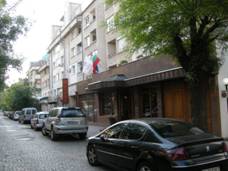 This is where the day plummeted. We were dropped off at the Hotel Geneva in the bowels of Sofia. The rooms were very tired, the carpet in ours was threadbare and filthy, the street noise was extremely invasive and the temperature control on the air conditioning was non-existent; the duvet didn’t even cover the mattress. The worst was still to come; we shared the small dining room with a dozen others, all of whom chain smoked, making a very mediocre meal even more miserable. To be fair to Neophron, we had asked to upgrade our accommodation wherever possible and this hotel claimed 4 stars, God knows how. “It’s time to go home”.
This is where the day plummeted. We were dropped off at the Hotel Geneva in the bowels of Sofia. The rooms were very tired, the carpet in ours was threadbare and filthy, the street noise was extremely invasive and the temperature control on the air conditioning was non-existent; the duvet didn’t even cover the mattress. The worst was still to come; we shared the small dining room with a dozen others, all of whom chain smoked, making a very mediocre meal even more miserable. To be fair to Neophron, we had asked to upgrade our accommodation wherever possible and this hotel claimed 4 stars, God knows how. “It’s time to go home”.
DAY 13 – High Tops
To-day was our last and a chance to get to grips with some high altitude species, with Nutcracker taking pride of place. Nutcracker had been encountered earlier in the trip with a fly-by singleton, missed by yours truly and a silhouetted bird on top of a distant pine. Unfortunately not sufficiently good views were had, so no tick. Mount Vitosha, standing over 7,000 feet and located a few kilometres outside Sofia was our destination.
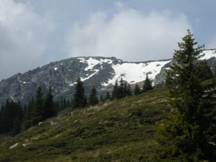 With the summit still covered with snow, temperatures struggled to reach double figures; a stark contrast to our afternoons birding back on the plains, where temperatures were in the mid 20s. We parked at the ski resort and made our way through the resort onto one of the many trails. Ring Ouzel were heard calling from the stands of pines, but not located. A couple of distant Nutcracker were observed on a chair-lift pylon, giving less than adequate views. All changed, however, when a couple of hundred metres along the track a very obliging bird perched out on a pine branch less than 50 metres away, giving feather-sharp images in both binoculars and cameras. A bird very much on our “most wanted list” and giving such great views, it can’t get any better than that. A Firecrest was also very obliging, posing in every position imaginable for several minutes.
With the summit still covered with snow, temperatures struggled to reach double figures; a stark contrast to our afternoons birding back on the plains, where temperatures were in the mid 20s. We parked at the ski resort and made our way through the resort onto one of the many trails. Ring Ouzel were heard calling from the stands of pines, but not located. A couple of distant Nutcracker were observed on a chair-lift pylon, giving less than adequate views. All changed, however, when a couple of hundred metres along the track a very obliging bird perched out on a pine branch less than 50 metres away, giving feather-sharp images in both binoculars and cameras. A bird very much on our “most wanted list” and giving such great views, it can’t get any better than that. A Firecrest was also very obliging, posing in every position imaginable for several minutes.
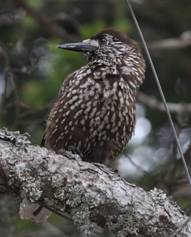 Several common birds, but new for the trip were encountered including Wren, Dunnock, Coal Tit & Chiffchaff – all birds of higher altitudes in Bulgaria. An unproductive hour at a known Rock Thrush site saw us back at the ski centre by lunch time. Whilst eating our packed lunch, 2 Ring Ouzel landed on an adjacent Pine, but refused to give themselves up to the camera lens, keeping partly hidden, before flying off down the slope. It was then we spotted a Nutcracker on a rubbish bin, obviously unsuccessfully searching for tasty morsels. It noticed that we were eating lunch and flew onto the low limb of a Pine just above our heads. Turning his head from side to side as if looking for any dropped crumbs, I doubt if better views could be had unless you had the bird in your hand, “absolutely fantastic”.
Several common birds, but new for the trip were encountered including Wren, Dunnock, Coal Tit & Chiffchaff – all birds of higher altitudes in Bulgaria. An unproductive hour at a known Rock Thrush site saw us back at the ski centre by lunch time. Whilst eating our packed lunch, 2 Ring Ouzel landed on an adjacent Pine, but refused to give themselves up to the camera lens, keeping partly hidden, before flying off down the slope. It was then we spotted a Nutcracker on a rubbish bin, obviously unsuccessfully searching for tasty morsels. It noticed that we were eating lunch and flew onto the low limb of a Pine just above our heads. Turning his head from side to side as if looking for any dropped crumbs, I doubt if better views could be had unless you had the bird in your hand, “absolutely fantastic”.
We again headed some 30+ kilometres out of town to another wetland with extensive reedbeds. Bittern could be heard booming and it wasn’t long before one was observed, flying low over the reeds. Another new tick was had in the guise of a Marsh Warbler, who showed well, but was more intent on territorial disputes than posing for us. Again we spent an inordinate amount of time & energy trying to photograph a Barred Warbler without any success and not for the first time this trip. Other birds noted were Great & Little Egret, Squacco Heron, Little & Temminck’s Stint, Lapwing, Marsh Harrier and many, many Black-headed Yellow Wagtail, to name just a few. A perfect end to a great day. The only fly in the ointment was returning to Hotel Geneva for our final night.
WEATHER
As you would expect at this time of the year, the weather was mixed and was split into two. Cool, with a chance of rain at higher elevations with temperatures ranging from 10-16 degrees, whilst on the Black Sea coast it was much drier with a temperature range of 18-25 degrees.
CURRENCY
Although Bulgaria is part of the EU and in the Euro zone, it appeared to us that the Lev was the currency of choice, especially once you were away from the major conurbations. Changing Euros into Lev at hotels is not recommended as the rate offered is usually very poor.
BUGS & BEASTIES
No biting insects were encountered during our visit, even at some of the extensive wetlands.
HOTELS
With the exception of the Hotel Geneva (see DAY 12 above), all the hotels we stayed at were clean, comfortable and of good quality. Free Wi-fi was a feature everywhere much to our surprise.
FOOD
In the main, the food is acceptable; don’t expect fresh vegetables with your meals unless requested. Salads are very popular, the basis of which is very chunky pieces of cucumber and tomato; other added ingredients will determine the type of salad on the menu. Greek is very popular. Meat dishes consist in the main of Chicken, Pork & Veal. Beef, in the form of steak is on some menus, but the cost is usually at least twice the price of other meats. Soups are readily available and are, in the main, tasty. The concept of what a sandwich is, varies greatly depending on where you are. Scrambled, fried and boiled eggs with toast is usually available for breakfast, together with the usual hams, cheeses and yoghurts.
THE GUIDE
Our guide/driver was supplied by Neophron Ltd. Mladen was a very accomplished birder, with an excellent ear for bird calls. He was also an excellent photographer, which turned out to be his passion. In fact Mladen leads the majority of the photographic tours offered by Neophron. Having used many birding guides the world over, we found Mladen’s approach vastly different to theirs. They always give the impression that they are really pleased to meet you and are enthusiastic to discuss all matters from weather, clothing requirements, local foods, birds seen recently or the birds expected to be seen during the trip, birding sites to be visited etc., etc.
Our meeting at the airport can only be described as cordial. On our initial 4 hour drive, where enthusiastic questions were being asked, they were either met with a simple yes or no, or in many cases a shrug of the shoulders. Not the most enthusiastic start then and eventually the drive descended into stony silence.
We think it’s not unfair to say that Mladen was not a morning person; we soon realised that conversations on the plan of action, around the breakfast table, were best left for later. We think he must have noted our patience was wearing a little thin, as his attitude changed slightly for the better after the third day. He was still prone to dark moods which usually lasted for several hours and usually manifested themselves in silence, fast driving, violent swerving to miss the many potholes, or wandering off with his camera. It’s probably not in the Bulgarian make-up to be ebullient, but we did note a change in his manner when, on the odd occasion, he met other guides he apparently knew.
Mladen has the ability to be both very charming and engaging, it’s just a pity we didn’t see that side of him more often.
We are very much indebted to Mladen for his infinite patience when it came to explaining the functions of our cameras and how to get the best from them in less than perfect conditions. We’re not sure if the quality of our photos improved, but we certainly had fewer bad ones.
MOANS, GROANS & MEMORABLE MOMENTS
Groan
The attitude of the security staff at Heathrow Terminal 5 – it’s the worst we have ever experienced.
Moan
Again, this concerns Terminal 5. On our arrival at the “short stay business car park” we were enthusiastically offered a ride on the futuristic “Pod”. It’s a driverless transport system, shaped like Mork’s spaceship, that takes you from the car park right into terminal 5; it was great. The moan comes on our return; no signs to tell you where it was and terminal staff who gave wrong directions. Not what you want on your return. We eventually caught the bus.
Groan
Inconsiderate Dutch photographers who appeared content to photograph from their respective buses, until we arrived. They then piled out, pushing all the waders to the back of the salt pans. We can only presume, they thought that was what we were going to do!
Memorable Moments
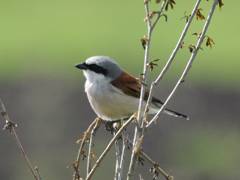 There were far too many memorable birding moments to list them all. Incidents of visible migration are always spectacular, like hundreds of White Stork climbing on thermals to gain height. The same with White Pelican and the fly-over of dozens of Glossy Ibis. The Wallcreeper, building its nest in Trigrad gorge. The Peregrine clutching the Alpine Swift in its talons, whilst it’s young called enthusiastically for the meal they were about to receive. Getting views of two lifers we just couldn’t have dreamed of; the Paddyfield Warbler and the Nutcracker. The Scops Owl called into a Pine tree just above our heads. The list goes on and on.
There were far too many memorable birding moments to list them all. Incidents of visible migration are always spectacular, like hundreds of White Stork climbing on thermals to gain height. The same with White Pelican and the fly-over of dozens of Glossy Ibis. The Wallcreeper, building its nest in Trigrad gorge. The Peregrine clutching the Alpine Swift in its talons, whilst it’s young called enthusiastically for the meal they were about to receive. Getting views of two lifers we just couldn’t have dreamed of; the Paddyfield Warbler and the Nutcracker. The Scops Owl called into a Pine tree just above our heads. The list goes on and on.
SUMMARY
The total number of birds seen during the trip was 190, with 7 lifers; Nutcracker, Paddyfield Warbler, Dalmatian Pelican, Levant Sparrowhawk, Eastern Imperial Eagle, Caspian Gull and Thrush Nightingale – a very good return on the hours actually spent in the field.
With our birding taking us right across Bulgaria, as far south as the border with Greece, west to the Black Sea and north to within touching distance of Romania we spent, as expected, a lot of time on the road. We stayed in six different hotels and travelled a distance of almost 2,000 kilometres.
A primary reason for taking this trip was that many of those special European species like Roller, Bee-eater, shrikes, orioles, woodpeckers, etc are common in Bulgaria and it would present us with the opportunity of both adding to and improving the quality of birds in our photographic library.
Both the birding and the photography met our every expectation and Bulgaria is a birding destination we wholeheartedly recommend.
